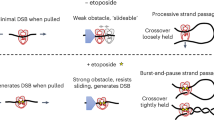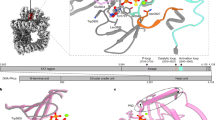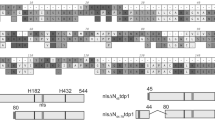Abstract
The inhibition of DNA topoisomerase I (Top1) has proven to be a successful approach in the design of anticancer agents. However, despite the clinical successes of the camptothecin derivatives, a significant need for less toxic and more chemically stable Top1 inhibitors still persists. Here, we describe one of the most frequently used protocols to identify novel Top1 inhibitors. These methods use uniquely 3′-radiolabeled DNA substrates and denaturing polyacrylamide gel electrophoresis to provide evidence for the Top1-mediated DNA cleaving activity of potential Top1 inhibitors. These assays allow comparison of the effectiveness of different drugs in stabilizing the Top1-DNA intermediate or cleavage (cleavable) complex. A variation on these assays is also presented, which provides a suitable system for determining whether the inhibitor blocks the forward cleavage or religation reactions by measuring the reversibility of the drug-induced Top1–DNA cleavage complexes. This entire protocol can be completed in ∼2 d.
This is a preview of subscription content, access via your institution
Access options
Subscribe to this journal
Receive 12 print issues and online access
$259.00 per year
only $21.58 per issue
Buy this article
- Purchase on SpringerLink
- Instant access to full article PDF
Prices may be subject to local taxes which are calculated during checkout







Similar content being viewed by others
References
Kohlhagen, G., Paull, K., Cushman, M., Nagafufuji, P. & Pommier, Y. Protein-linked DNA strand breaks induced by NSC 314622, a non-camptothecin topoisomerase I poison. Mol. Pharmacol. 54, 50–58 (1998).
Strumberg, D. et al. Synthesis of cytotoxic indenoisoquinoline topoisomerase I poisons. J. Med. Chem. 42, 446–457 (1999).
Antony, S. et al. Cellular Topoisomerase I Inhibition and antiproliferative activity by MJ-III-65 (NSC 706744), an indenoisoquinoline topoisomerase I poison. Mol. Pharmacol. 67, 523–530 (2005).
Ioanoviciu, A. et al. Synthesis and mechanism of action studies of a series of norindenoisoquinoline topoisomerase I poisons reveal an inhibitor with a flipped orientation in the ternary DNA-enzyme-inhibitor complex as determined by X-ray crystallographic analysis. J. Med. Chem. 48, 4803–4814 (2005).
Staker, B.L. et al. Structures of three classes of anticancer agents bound to the human topoisomerase I-DNA covalent complex. J. Med. Chem. 48, 2336–2345 (2005).
Antony, S. et al. Novel indenoisoquinolines NSC 725776 and NSC 724998 produce persistent topoisomerase I cleavage complexes and overcome multidrug resistance. Cancer Res. 67, 10397–10405 (2007).
Tanizawa, A., Kohn, K.W., Kohlhagen, G., Leteurtre, F. & Pommier, Y. Differential stabilization of eukaryotic DNA topoisomerase I cleavable complexes by camptothecin derivatives. Biochemistry 34, 7200–7206 (1995).
Pommier, Y. et al. Interaction of an alkylating camptothecin derivative with a DNA base at topoisomerase I-DNA cleavage sites. Proc. Natl. Acad. Sci. USA 92, 8861–8865 (1995).
Urasaki, Y., Takebayashi, Y. & Pommier, Y. Activity of a novel camptothecin analogue, homocamptothecin, in camptothecin-resistant cell lines with topoisomerase I alterations. Cancer Res. 60, 6577–6580 (2000).
Gamcsik, M.P. et al. Dual role of glutathione in modulating camptothecin activity: depletion potentiates activity, but conjugation enhances the stability of the topoisomerase I-DNA cleavage complex. Mol. Cancer Ther. 1, 11–20 (2001).
Takagi, K. et al. Novel E-ring camptothecin keto analogues (S38809 and S39625) are stable, potent, and selective topoisomerase I inhibitors without being substrates of drug efflux transporters. Mol. Cancer Ther. 6, 3229–3238 (2007).
Morham, S., Kluckman, K.D., Voulomanos, N. & Smithies, O. Targeted disruption of the mouse topoisomerase I gene by camptothecin selection. Mol. Cell. Biol. 16, 6804–6809 (1996).
Zhang, C.X., Chen, A.D., Gettel, N.J. & Hsieh, T.S. Essential functions of DNA topoisomerase I in Drosophila melanogaster . Dev. Biol. 222, 27–40 (2000).
Christman, M.F., Dietrich, F.S. & Fink, G.R. Mitotic recombination in the rDNA of S. cerevisiae is suppressed by the combined action of DNA topoisomerase I and II. Cell 55, 413–425 (1988).
Zhang, H. et al. Human mitochondrial topoisomerase I. Proc. Natl. Acad. Sci. USA 98, 10608–10613 (2001).
Zhang, H., Meng, L.H., Zimonjic, D.B., Popescu, N.C. & Pommier, Y. Thirteen-exon-motif signature for vertebrate nuclear and mitochondrial type IB topoisomerases. Nucleic Acids Res. 32, 2087–2092 (2004).
Champoux, J.J. DNA topoisomerases: structure, function, and mechanism. Annu. Rev. Biochem. 70, 369–413 (2001).
Wang, J.C. Cellular roles of DNA topoisomerases: a molecular perspective. Nat. Rev. Mol. Cell Biol. 3, 430–440 (2002).
Pommier, Y. Topoisomerase I inhibitors: camptothecins and beyond. Nat. Rev. Cancer 6, 789–802 (2006).
Stewart, L., Redinbo, M.R., Qiu, X., Hol, W.G.J. & Champoux, J.J. A model for the mechanism of human topoisomerase I. Science 279, 1534–1541 (1998).
Lesher, D.T., Pommier, Y., Stewart, L. & Redinbo, M.R. 8-Oxoguanine rearranges the active site of human topoisomerase I. Proc. Natl. Acad. Sci. USA 99, 12102–12107 (2002).
Staker, B.L. et al. The mechanism of topoisomerase I poisoning by a camptothecin analog. Proc. Natl. Acad. Sci. USA 99, 15387–15392 (2002).
Koster, D.A., Croquette, V., Dekker, C., Shuman, S. & Dekker, N.H. Friction and torque govern the relaxation of DNA supercoils by eukaryotic topoisomerase IB. Nature 434, 671–674 (2005).
Leteurtre, F. et al. Effects of DNA methylation on topoisomerase I and II cleavage activities. J. Biol. Chem. 269, 7893–7900 (1994).
Henningfeld, K.A. & Hecht, S. A model for topoisomerase I-mediated insertions and deletions with duplex DNA substrates containing branches, nicks, and gaps. Biochemistry 34, 6120–6129 (1995).
Yeh, Y.-C., Liu, H.-F., Ellis, C.A. & Lu, A.-L. Mammalian topoisomerase I has a mismatch nicking activity. J. Biol. Chem. 269, 15498–15504 (1994).
Pourquier, P. et al. Trapping of mammalian topoisomerase I and recombinations induced by damaged DNA containing nicks or gaps: importance of DNA end phosphorylation and camptothecin effects. J. Biol. Chem. 272, 26441–26447 (1997).
Pourquier, P. et al. Effects of uracil incorporation, DNA mismatches, and abasic sites on cleavage and religation activities of mammalian topoisomerase I. J. Biol. Chem. 272, 7792–7796 (1997).
Pourquier, P., Bjornsti, M.A. & Pommier, Y. Induction of topoisomerase I cleavage complexes by the vinyl chloride adduct 1,N6-ethenoadenine. J. Biol. Chem. 273, 27245–27249 (1998).
Takebayashi, Y., Pourquier, P., Yoshida, A., Kohlhagen, G. & Pommier, Y. Poisoning of human DNA topoisomerase I by ecteinascidin 743, an anticancer drug that selectively alkylates DNA in the minor groove. Proc. Natl. Acad. Sci. USA 96, 7196–7201 (1999).
Pourquier, P. et al. Gemcitabine (2′,2′-difluoro-2′-deoxycytidine), an antimetabolite that poisons topoisomerase I. Clin. Cancer Res. 8, 2499–2504 (2002).
Pourquier, P. & Pommier, Y. Topoisomerase I-mediated DNA damage. Adv. Cancer Res. 80, 189–216 (2001).
Pourquier, P. et al. Topoisomerase I-mediated cytotoxicity of N-methyl-N′-nitro-N-nitrosoguanidine: trapping of topoisomerase I by the O6-methylguanine. Cancer Res. 61, 53–58 (2001).
Dexheimer, T.S., Kozekova, A., Rizzo, C.J., Stone, M.P. & Pommier, Y. The modulation of topoisomerase I-mediated DNA cleavage and the induction of DNA-topoisomerase I crosslinks by crotonaldehyde-derived DNA adducts. Nucleic Acids Res. 36, 4128–4136 (2008).
Lanza, A., Tornatelli, S., Rodolfo, C., Scanavini, M.C. & Pedrini, A.M. Human DNA topoisomerase I-mediated cleavages stimulated by ultraviolet light-induced DNA damage. J. Biol. Chem. 271, 6978–6986 (1996).
Subramanian, D., Rosenstein, B.S. & Muller, M.T. Ultraviolet-induced DNA damage stimulates topoisomerase I-DNA complex formation in vivo: possible relationship with DNA repair. Cancer Res. 58, 976–984 (1998).
Chrencik, J.E., Burgin, A.B., Pommier, Y., Stewart, L. & Redinbo, M.R. Structural impact of the leukemia drug Ara-C on the covalent human topoisomerase I DNA complex. J. Biol. Chem. 278, 12461–12466 (2003).
Antony, S., Arimondo, P.B., Sun, J.S. & Pommier, Y. Position- and orientation-specific enhancement of topoisomerase I cleavage complexes by triplex DNA structures. Nucleic Acids Res. 32, 5163–5173 (2004).
Antony, S. et al. Enhancement of camptothecin-induced topoisomerase I cleavage complexes by the acetaldehyde adduct N2-ethyl-2′-deoxyguanosine. Nucleic Acids Res. 32, 5685–5692 (2004).
Pommier, Y. et al. Different effects on human topoisomerase I by minor groove and intercalated deoxyguanosine adducts derived from two polycyclic aromatic hydrocarbon diol epoxides at or near a normal cleavage site. J. Biol. Chem. 277, 13666–13672 (2002).
Pommier, Y. et al. Benzo[a]pyrene epoxide adducts in DNA are potent inhibitors of a normal topoisomerase I cleavage site and powerful inducers of other topoisomerase I cleavages. Proc. Natl. Acad. Sci. USA 97, 2040–2045 (2000).
Pommier, Y. et al. Position-specific trapping of topoisomerase I-DNA cleavage complexes by intercalated benzo[a]- pyrene diol epoxide adducts at the 6-amino group of adenine. Proc. Natl. Acad. Sci. USA 97, 10739–10744 (2000).
Sordet, O. et al. Apoptotic topoisomerase I-DNA complexes induced by staurosporine-mediated oxygen radicals. J. Biol. Chem. 279, 50499–50504 (2004).
Sordet, O., Khan, Q.A. & Pommier, Y. Apoptotic topoisomerase I-DNA complexes induced by oxygen radicals and mitochondrial dysfunction. Cell Cycle 3, 1095–1097 (2004).
Sordet, O. et al. Topoisomerase I-DNA complexes contribute to arsenic trioxide-induced apoptosis. J. Biol. Chem. 279, 33968–33975 (2004).
Soe, K., Rockstroh, A., Schache, P. & Grosse, F. The human topoisomerase I damage response plays a role in apoptosis. DNA Repair (Amst.) 3, 387–393 (2004).
Rockstroh, A., Kleinert, A., Kramer, M., Grosse, F. & Soe, K. Cellular stress triggers the human topoisomerase I damage response independently of DNA damage in a p53 controlled manner. Oncogene 26, 123–131 (2007).
Sordet, O., Goldman, A. & Pommier, Y. Topoisomerase II and tubulin inhibitors both induce the formation of apoptotic topoisomerase I cleavage complexes. Mol. Cancer Ther. 5, 3139–3144 (2006).
Ganguly, A. et al. Betulinic acid, a catalytic inhibitor of topoisomerase I, inhibits reactive oxygen species-mediated apoptotic topoisomerase I-DNA cleavable complex formation in prostate cancer cells but does not affect the process of cell death. Cancer Res. 67, 11848–11858 (2007).
Sen, N. et al. Apoptosis is induced in leishmanial cells by a novel protein kinase inhibitor withaferin A and is facilitated by apoptotic topoisomerase I-DNA complex. Cell Death Differ. 14, 358–367 (2007).
Sordet, O. et al. Topoisomerase I requirement for death receptor-induced apoptotic nuclear fission. J. Biol. Chem. 283, 23200–23208 (2008).
Pommier, Y. et al. Repair of topoisomerase I-mediated DNA damage. Prog. Nucleic Acid Res. Mol. Biol. 81, 179–229 (2006).
Bertrand, R., Solary, E., Kohn, K.W., O'Connor, P. & Pommier, Y. Induction of a common pathway to apoptosis by staurosporine. Exp. Cell Res. 211, 314–321 (1994).
Pommier, Y. & Cherfils, J. Interfacial protein inhibition: a nature's paradigm for drug discovery. Trends Pharmacol. Sci. 28, 136–145 (2005).
Marchand, C. et al. A novel norindenoisoquinoline structure reveals a common interfacial inhibitor paradigm for ternary trapping of topoisomerase I-DNA covalent complexes. Mol. Cancer Ther. 5, 287–295 (2006).
Nitiss, J. & Wang, J.C. DNA topoisomerase-targeting antitumor drugs can be studied in yeast. Proc. Natl. Acad. Sci. USA 85, 7501–7505 (1988).
Bjornsti, M.-A., Benedetti, P., Viglianti, G.A. & Wang, J.C. Expression of human DNA topoisomerase I in Yeast cells lacking yeast DNA topoisomerase I: restoration of sensitivity of the cells to the antitumor drug camptothecin. Cancer Res. 49, 6318–6323 (1989).
Wall, M.E. & Wani, M.C. Camptothecin and taxol: discovery to clinic—thirteenth Bruce F. Cain Memorial Award lecture. Cancer Res. 55, 753–760 (1995).
Sirikantaramas, S., Yamazaki, M. & Saito, K. Mutations in topoisomerase I as a self-resistance mechanism coevolved with the production of the anticancer alkaloid camptothecin in plants. Proc. Natl. Acad. Sci. USA 105, 6782–6786 (2008).
Fujimori, A., Harker, W.G., Kohlhagen, G., Hoki, Y. & Pommier, Y. Mutation at the catalytic site of topoisomerase I in CEM/C2, a human leukemia cell resistant to camptothecin. Cancer Res. 55, 1339–1346 (1995).
Hsiang, Y.H., Hertzberg, R., Hecht, S. & Liu, L.F. Camptothecin induces protein-linked DNA breaks via mammalian DNA topoisomerase I. J. Biol. Chem. 260, 14873–14878 (1985).
Teicher, B.A. Next generation topoisomerase I inhibitors: rationale and biomarker strategies. Biochem. Pharmacol. 75, 1262–1271 (2008).
Pratesi, G., Beretta, G.L. & Zunino, F. Gimatecan, a novel camptothecin with a promising preclinical profile. Anticancer Drugs 15, 545–552 (2004).
Jaxel, C., Kohn, K.W., Wani, M.C., Wall, M.E. & Pommier, Y. Structure-activity study of the actions of camptothecin derivatives on mammalian topoisomerase I: evidence for a specific receptor site and a relation to antitumor activity. Cancer Res. 49, 1465–1469 (1989).
Hsiang, Y.H. et al. DNA topoisomerase I-mediated DNA cleavage and cytotoxicity of camptothecin analogues. Cancer Res. 49, 4385–4389 (1989).
Mi, Z. & Burke, T.G. Differential interactions of camptothecin lactone and carboxylate forms with human blood components. Biochemistry 33, 10325–10336 (1994).
Strumberg, D. et al. Conversion of topoisomerase I cleavage complexes on the leading strand of ribosomal DNA into 5′-phosphorylated DNA double-strand breaks by replication runoff. Mol. Cell Biol. 20, 3977–3987 (2000).
Lavergne, O. et al. Homocamptothecins: synthesis and antitumor activity of novel E-ring-modified camptothecin analogues. J. Med. Chem. 41, 5410–5419 (1998).
Bailly, C. Homocamptothecins: potent topoisomerase I inhibitors and promising anticancer drugs. Crit. Rev. Oncol. Hematol. 45, 91–108 (2003).
Hautefaye, P. et al. Synthesis and pharmacological evaluation of novel non-lactone analogues of camptothecin. Bioorg Med. Chem. Lett. 13, 2731–2735 (2003).
Meng, L.-H., Liao, Z.-Y. & Pommier, Y. Non-camptothecin DNA topoisomerase I inhibitors in cancer chemotherapy. Curr. Topics Med. Chem. 3, 305–320 (2003).
Bailly, C. Topoisomerase I poisons and suppressors as anticancer drugs. Curr. Med. Chem. 7, 39–58 (2000).
Paull, K.D. et al. Display and analysis of patterns of differential activity of drugs against human tumor cell lines: development of a mean graph and COMPARE algorithm. J. Natl. Cancer Inst. 81, 1088–1092 (1989).
Yamashita, Y. et al. Induction of mammalian DNA topoisomerase I-mediated DNA cleavage by antitumor indolocarbazole derivatives. Biochemistry 31, 12069–12075 (1992).
Long, B.H., Rose, W.C., Vyas, D.M., Matson, J.A. & Forenza, S. Discovery of antitumor indolocarbazoles: rebeccamycin, NSC 655649, and fluoroindolocarbazoles. Curr. Med. Chem. Anticancer Agents 2, 255–266 (2002).
Li, T.K. et al. Characterization of ARC-111 as a novel topoisomerase I-targeting anticancer drug. Cancer Res. 63, 8400–8407 (2003).
Morrell, A., Antony, S., Kohlhagen, G., Pommier, Y. & Cushman, M. A systematic study of nitrated indenoisoquinolines reveals a potent topoisomerase I inhibitor. J. Med. Chem. 49, 7740–7753 (2006).
Antony, S. et al. Differential induction of topoisomerase I-DNA cleavage complexes by the indenoisoquinoline MJ-III-65 (NSC 706744) and camptothecin: base sequence analysis and activity against camptothecin-resistant topoisomerases I. Cancer Res. 63, 7428–7435 (2003).
Morrell, A. et al. Evaluation of indenoisoquinoline topoisomerase I inhibitors using a hollow fiber assay. Bioorg. Med. Chem. 16, 4395–4399 (2006).
Morrell, A. et al. Nitrated indenoisoquinolines as topoisomerase I inhibitors: a systematic study and optimization. J. Med. Chem. 50, 4419–4430 (2007).
Morrell, A. et al. Investigation of the lactam side chain length necessary for optimal indenoisoquinoline topoisomerase I inhibition and cytotoxicity in human cancer cell cultures. J. Med. Chem. 50, 2040–2048 (2007).
Svejstrup, J.Q., Christiansen, K., Andersen, A.H., Lund, K. & Westergaard, O. Minimal DNA duplex requirements for topoisomerase I-mediated cleavage in vitro . J. Biol. Chem. 265, 12529–12535 (1990).
Bonven, B.J., Gocke, E. & Westergaard, O. A high affinity topoisomerase I binding sequence is clustered at DNAase I hypersensitive sites in Tetrahymena R-chromatin. Cell 41, 541–551 (1985).
Christiansen, K., Svejstrup, A.B., Andersen, A.H. & Westergaard, O. Eukaryotic topoisomerase I-mediated cleavage requires bipartite DNA interaction. Cleavage of DNA substrates containing strand interruptions implicates a role for topoisomerase I in illegitimate recombination. J. Biol. Chem. 268, 9690–9701 (1993).
Jaxel, C., Capranico, G., Kerrigan, D., Kohn, K.W. & Pommier, Y. Effect of local DNA sequence on topoisomerase I cleavage in the presence or absence of camptothecin. J. Biol. Chem. 266, 20418–20423 (1991).
Antony, S. et al. Bisindenoisoquinoline bis-1,3-{(5,6-dihydro-5,11-diketo-11H-indeno[1,2-c]isoquinoline)-6-propyla mino}propane bis(trifluoroacetate) (NSC 727357), a DNA intercalator and topoisomerase inhibitor with antitumor activity. Mol. Pharmacol. 70, 1109–1120 (2006).
Bjornsti, M.-A. & Osheroff, N. (eds.) DNA topoisomerase protocols. DNA topology and enzymes Vol. 94 (Humana Press, Totowa, NJ, 1999).
Pommier, Y., Covey, J.M., Kerrigan, D., Markovits, J. & Pham, R. DNA unwinding and inhibition of mouse leukemia L1210 DNA topoisomerase I by intercalators. Nucleic Acids Res. 15, 6713–6731 (1987).
Jaxel, C., Kohn, K.W. & Pommier, Y. Topoisomerase I interaction with SV40 DNA in the presence and absence of camptothecin. Nucleic Acids Res. 16, 11157–11170 (1988).
McClendon, A.K. & Osheroff, N. The geometry of DNA supercoils modulates topoisomerase-mediated DNA cleavage and enzyme response to anticancer drugs. Biochemistry 45, 3040–3050 (2006).
Kohn, K.W. DNA filter elution: a window on DNA damage in mammalian cells. Bioessays 18, 505–513 (1996).
Trask, D.K., DiDonato, J.A. & Muller, M.T. Rapid detection and isolation of covalent DNA/protein complexes: application to topoisomerase I and II. Embo. J. 3, 671–676 (1984).
El-Khamisy, S.F. et al. Defective DNA single-strand break repair in spinocerebellar ataxia with axonal neuropathy-1. Nature 434, 108–113 (2005).
Laco, G.S. et al. Analysis of human topoisomerase I inhibition and interaction with the cleavage site +1 deoxyguanosine, via in vitro experiments and molecular modeling studies. Bioorg. Med. Chem. 12, 5225–5235 (2004).
Maxam, A. & Gilbert, W. Sequencing end-labeled DNA with base-specific chemical cleavages. Meth. Enzymol. 65, 499–560 (1980).
Pommier, Y., Pourquier, P., Urasaki, Y., Wu, J. & Laco, G.S. Topoisomerase I inhibitors: selectivity and cellular resistance. Drug Resist. Updat. 2, 307–318 (1999).
Yoshinari, T. et al. Mode of action of a new indolocarbazole anticancer agent, J-107088, targeting topoisomerase I. Cancer Res. 59, 4271–4275 (1999).
Zhu, S. et al. Esters and amides of 2,3-dimethoxy-8,9-methylenedioxy-benzo[i]phenanthridine-12-carboxylic acid: potent cytotoxic and topoisomerase I-targeting agents. Bioorg. Med. Chem. 13, 6782–6794 (2005).
Acknowledgements
Our studies are supported by the Intramural Program of the Center for Cancer Research, NCI, NIH. We thank all members of the Laboratory of Molecular Pharmacology, past and present, for their contributions. Special thanks to Dr Kurt W. Kohn who pioneered studies on DNA topoisomerases and first proposed the trapping of topoisomerases by anticancer drugs (Ross, W.E., Glaubiger, D. & Kohn, K.W. Qualitative and quantitative aspects of intercalator-induced DNA strand breaks. Biochim. Biophys. Acta 562, 41–50 (1979)).
Author information
Authors and Affiliations
Corresponding author
Ethics declarations
Competing interests
The authors declare no competing financial interests.
Rights and permissions
About this article
Cite this article
Dexheimer, T., Pommier, Y. DNA cleavage assay for the identification of topoisomerase I inhibitors. Nat Protoc 3, 1736–1750 (2008). https://doi.org/10.1038/nprot.2008.174
Published:
Issue Date:
DOI: https://doi.org/10.1038/nprot.2008.174



